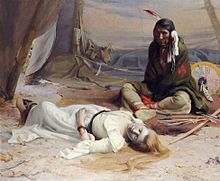Josephine Meeker
Josephine, her mother Arvilla Meeker, and Mrs. Shadruck Price and her two children were taken captive and held hostage by the Ute tribe for 23 days.
General Charles Adams, of the Colorado Militia that arranged the captives' release, conducted an official investigation of the incident.
Josephine Meeker's testimony provides keen insight into the experiences a white woman underwent as an Indian captive.
[1] Working for some time in Washington, D.C., and then for Senator Henry Moore Teller in Colorado, Meeker died young at age 25 of a pulmonary infection.
In 1870, at the age of 13, she moved with her family to the Union Colony in Greeley, Colorado, a utopian agricultural settlement which her father had founded.
[2] Riding astride rather than using the side-saddle recommended for women, she was said to challenge boys to horse races in the road.
A man got out to go for reinforcements; the survivors barricaded themselves behind their dead animals and wagons and held out until October 8, when help arrived.
[8] Josephine Meeker said of her captivity, "We all owe our lives to the sister of Chief Ouray..."[8] On October 21, the pioneer women and children were rescued by Charles Adams, a general of the Colorado Militia.
[10] In 1880, the US Congress held an inquiry into the massacre, at which Chief Ouray, Chipeta, and General Adams testified at the hearing.
Before Adams took Meeker away from the camp, Persune promised that she would not have to perform any domestic tasks if she would stay with him as his wife.
The following inscription on her tombstone was written by her mother:"Born Jany 28, 1857 Died December 20, 1882 Brave daughter who with me escaped foul death while captive in thy noble father slayers' hands A stealthier foe has filched thy sweet young breath while lonely here I watch life's failing sands."

